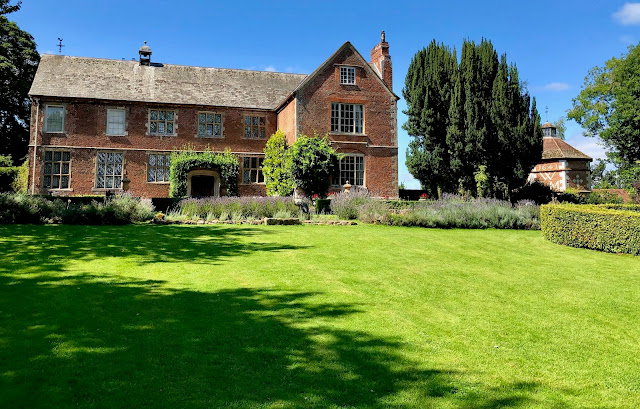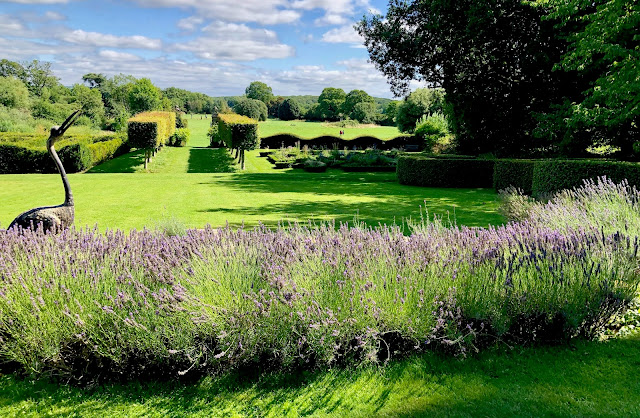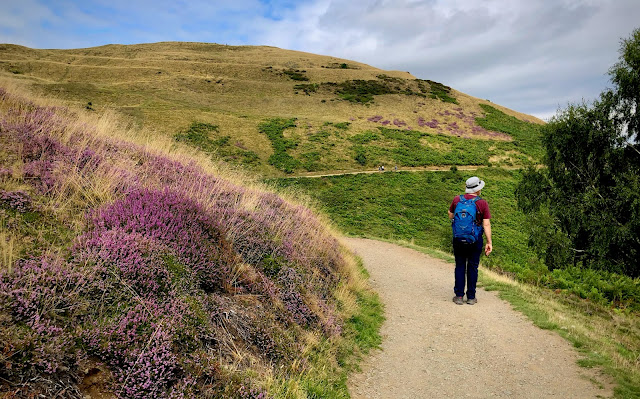 |
| Church Street, Ledbury - looking towards St Michael & All Angels Church |
Hello Readers!
Sadly, still no adventures in exotic foreign locations to share - we remain confined to the UK.
We have been unwilling to risk travelling abroad for a second year due to Covid risk, the huge expense of additional testing and, potentially, hotel quarantine on return to the UK. As such, my blog posts have been few and far between throughout 2020 and 2021, though there are so many beautiful places in the UK to see and I hope that content - intermittent though it might be - fills the gap somewhat.
I took a few days off work in the middle of August, looking to avoid anywhere too crowded with summer holidaymakers so the coast was obviously not an option. We embraced the opportunity to explore more of Herefordshire, a county just this side of the Welsh border. We have briefly visited bits of Herefordshire in the past, but the majority of the area was hitherto unfamiliar to us. In addition to sharing a border with Wales, Herefordshire bumps up against Gloucestershire (ie Cotswolds), Worcestershire and Shropshire.
I hoped that the small market town of Ledbury would be a good base to visit that part of the country. It was indeed.
 |
| The Feathers Hotel, one of the many black-and-white buildings in Ledbury |
 |
| Ledbury's high street: St Katherine's Hospital & Almshouses (left), the Barrett Browning Institute with its striking clocktower (excuse the pun), and the War Memorial (right) |
 |
| Ledbury Market House, built in 1617 |
 |
| One of the many lanes off Ledbury's high street |
 |
| The living room of our Air B&B apartment in the centre of Ledbury |
 |
| Our Air B&B bedroom, inside the pitched roof of the building, with ancient beams exposed. Care had to be taken not to smack one's head on the sloping ceiling when rising... |
We found plenty of interesting attractions within easy distance of Ledbury, including the historic property of Hellens Manor in the pleasingly, alliteratively named village of Much Marcle. The house is very old, with Tudor, Jacobean and Georgian sections and although the entire estate is now owned and managed by a charitable trust, descendants of the original owners still reside there. The grounds are lovely and varied and include a physic garden, a labyrinth, a knot garden, various ponds and orchards and even some standing stones in the field outside the formal part of the grounds (though they're not of the ancient kind; they're essentially modern sculptures with literary quotes carved into them).
At the time of planning our visit the guided tours of the house were all booked out, but a pleading enquiry at the café desk saw us being squeezed in to join another ten people for an hour-long, very fascinating journey into Hellens' history. The tour was led by one of the resident family and I was very gratified to see that although face masks are no longer enforceable in England, every single person on the tour voluntarily wore a mask while we were inside the house.
We had perfect weather - as the shots below confirm - and we took the opportunity to indulge in a cream tea, sitting outside in the courtyard in the company of half a dozen very friendly chickens who roamed freely and hovered around the tables, hoping to score a crumb or two from our scones.
 |
| The main section of the house (and dovecote in the right of the photo) - Hellens in Much Marcle, Herefordshire |
 |
| A very nice cast sculpture on the Cedar Lawn at Hellens, Much Marcle |
 |
| Yours Truly testing the swing for comfort |
 |
| View from the house towards The Labyrinth, The Knot Garden and The Standing Stones (just visible in the distance) |
 |
| The house has been added to over the centuries - our tour commenced through this doorway, in the oldest part of the house |
We also visited an historic estate, Croome Park, some of which has only been in the National Trust portfolio since 2007. It's just over the county border in Worcestershire.
The Neo-Palladian house - Croome Court - was completed in 1752, and is a rare example of Capability Brown's architectural work; it was his first major architectural project and his first-ever landscape design.
In 1948 Croome and most of its contents were sold due to the Coventry family falling on hard times, becoming firstly a school for disadvantaged boys and then a Hare Krishna retreat (!), before being purchased by property developers. For more than ten years the estate was in decline because the developers could not keep up with the cost of maintaining it, and eventually in 1996 the National Trust acquired the parkland but was unable to purchase the house, stables and walled gardens due to the extensive repair costs.
In 2007 The Croome Heritage Trust purchased Croome Court and leased it to the National Trust. It's now been open to the public since 2009 but although the house has been made watertight and structurally sound, it's yet to be properly restored and the rooms are empty of furniture and furnishings.
It was a nice enough way to spend a couple of hours but we wouldn't recommend going out of your way to visit Croome - at least until the house is properly restored.
 |
| Croome Hall, near Upton-upon-Severn in Worcestershire |
 |
| Although the rooms are now empty, some vestiges of Croome Hall's former opulence remain |
 |
| The National Trust has managed to buy back some of Croome's vast collection of Sèvres, Meissen and Worcester porcelain |
 |
| Twin Coade stone sphinxes decorate the main entrance to Croome Hall |
 |
| Despite not being a natural body of water (it was created as part of Capability Brown's landscape design), the Croome River is now home to wildlife such as otters (not that we saw any...) |
 |
| The Rotunda in the grounds of Croome Park |
Of course whilst staying in Ledbury we took advantage of being on the edge of the beautiful Malvern Hills to do some walking, notably a loop walk from the road below British Camp / Herefordshire Beacon (one of the highest peaks in the Malvern Hills at 338 metres), on to Swinyard Hill and then back again. British Camp is an Iron Age hill fort which held a settlement between the 4th century BC and 1st century BC.
(Fun fact: I have discovered that the term 'BC' is being replaced with 'BCE' or even just 'CE' - ie, Before Common Era / Common Era. You can read more about this here.)
There were some fairly steep hill sections to climb but these were well worth our labours, rewarding us with glorious 360-degree views across three counties - Herefordshire, Worcestershire and Gloucestershire.
 |
| A patchwork quilt of countryside across three counties - the view from Herefordshire Beacon |
 |
| Kevin and Yours Truly, happy to be at the top of Herefordshire Beacon |
 |
| The hillsides were dotted with clumps of purple heather |
And, lastly, the churches. Thanks to my personal researcher and Fount of All Knowledge, Lesley Williams, we sought out two historic churches just south of Ledbury.
The first was All Saints Church in Brockhampton, not far from Ross-on-Wye. Designed by W R Lethaby and completed in 1902, this glorious Arts and Crafts gem is considered one of the most important church examples of the Modern Movement. On either side of the altar are two tapestries made by the William Morris Workshops from designs by Edward Burne-Jones, but otherwise there's a real sense of simplicity, particularly in the internal architectural features.
Its location is just about perfection, nestling within the Brockhampton Court Estate.
A few years ago this little church was visited by four members of a Japanese property group, purely by chance. They promptly fell in love with it and embarked on a plan to replicate the building on the 21st and 22nd floors of the skyscraper Monterey Grasmere Hotel in Osaka in Japan. The replica is used as a western-style wedding venue.
 |
| The sublime All Saints Church in Brockhampton, not far from Ross-on-Wye in Herefordshire |
 |
| Rambling rose on one of the exterior walls, All Saints Church in Brockhampton |
 |
| Quatrefoil mullioned windows in All Saints Church, Brockhampton |
 |
| The simplicity of the interior of All Saints Church in Brockhampton |
 |
| One of the two William Morris Workshops tapestries designed by Pre-Raphaelite artist Edward Burne-Jones |
 |
| ... and this is the view, just across the street from All Saints Church in Brockhampton |
 |
| Service building at the main gate of Brockhampton Court, now a private care home (across the road from the church) |
The second church recommended to us by Lesley was equally as impressive, but for different reasons.
St Mary's at Kempley, just over the border in Gloucestershire, is one of those buildings that really inspires awe. This church has been standing for almost 900 years - yep, NINE HUNDRED (since 1130).
Not only that, the interior is covered with some of the most significant Romanesque wall paintings in England, dating from the same period. It is truly incredible that they have not been destroyed throughout all those centuries, although following the reformation and its hostility towards religious art (16th century), the paintings were covered by whitewash and only rediscovered in 1872. English Heritage describes these paintings as 'a vivid reminder of a time when church interiors were covered in such decoration.'
You want more? Additionally this church has what is believed to be one of the earliest existing roof structures in all of Britain and Europe.
We were agog, contemplating the centuries of history contained in this little country church.
 |
| The pretty pink exterior of St Mary's in Kempley, Gloucestershire |
 |
| Example of the Romanesque wall paintings of St Mary's in Kempley - inspiring worshippers for nearly 900 years. The chequerboard pattern is designed to draw the eye towards the narrow opening |
 |
| Further examples of the ancient wall paintings inside St Mary's in Kempley |
So there you have it - just one small corner of Herefordshire kept us richly entertained and I think you'll agree we crammed in a lot over just four days!
I remain impressed at the vast wealth of fascinating places in this relatively small, beautiful country.
Until next time,
- Maree xo
No comments:
Post a Comment